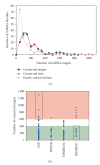An evolutionary perspective of animal microRNAs and their targets
- PMID: 19759918
- PMCID: PMC2743850
- DOI: 10.1155/2009/594738
An evolutionary perspective of animal microRNAs and their targets
Abstract
MicroRNAs (miRNAs) are short noncoding RNAs that regulate gene expression through translational inhibition or mRNA degradation by binding to sequences on the target mRNA. miRNA regulation appears to be the most abundant mode of posttranscriptional regulation affecting approximately 50% of the transcriptome. miRNA genes are often clustered and/or located in introns, and each targets a variable and often large number of mRNAs. Here we discuss the genomic architecture of animal miRNA genes and their evolving interaction with their target mRNAs.
Figures




References
-
- Ambros V. The functions of animal microRNAs. Nature. 2004;431(7006):350–355. - PubMed
-
- Bartel DP. MicroRNAs: genomics, biogenesis, mechanism, and function. Cell. 2004;116(2):281–297. - PubMed
-
- He L, Hannon GJ. MicroRNAs: small RNAs with a big role in gene regulation. Nature Reviews Genetics. 2004;5(7):522–531. - PubMed
-
- Du T, Zamore PD. microPrimer: the biogenesis and function of microRNA. Development. 2005;132(21):4645–4652. - PubMed
-
- Filipowicz W, Jaskiewicz L, Kolb FA, Pillai RS. Post-transcriptional gene silencing by siRNAs and miRNAs. Current Opinion in Structural Biology. 2005;15(3):331–341. - PubMed
Publication types
MeSH terms
Substances
LinkOut - more resources
Full Text Sources

